Monthly economic brief: June 2022
The monthly economic brief provides a summary of latest key economic statistics, forecasts and analysis on the Scottish economy.
This document is part of a collection
Consumption
Consumer sentiment weakened significantly in May to its lowest level since March 2021.
Consumer sentiment
- Consumer sentiment indicators continue to be highly sensitive to the rapidly changing economic environment as the economy recovers from the pandemic while at the same time households and consumers are facing significant challenges from the sharp rise in inflation and cost of living.
- These challenges have instensified since the start of the year, which has been reflected in a sharp drop off in the Scottish Consumer Sentiment Indicator.
- Latest data show consumer sentiment declined considerably over the month from -5.9 in April to -9.1 in May. Overall, consumer sentiment has fallen 16.5 points since the start of the year and is at its lowest level since March 2021.[14],[15]
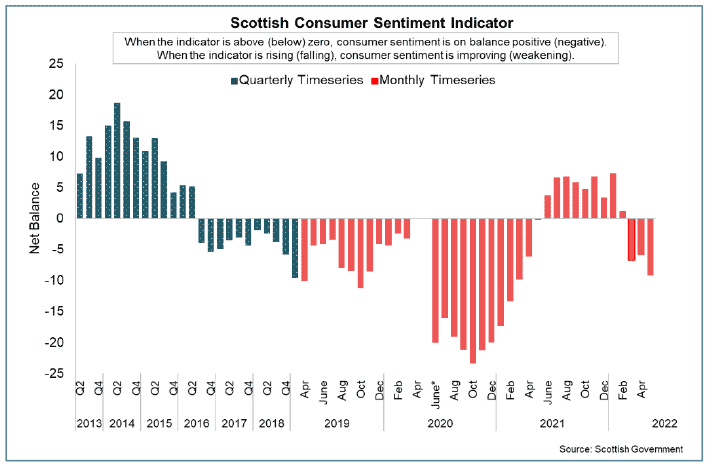
- On the economy, respondents on balance consider current economic circumstances to be worse than last year (-11.8. down from -5.6 in April). Looking ahead, respondents expect the economy to impove over the coming year relative to the current situation (+11.3), although the level of optimism has been on a downward trend since July 2021 and is down significantly on April where it was 19.4.
- In terms of households personal finances, respondents on balance continued to report that their household finances are less secure than 12 months ago (-16.5, down from -13.0 in April). Looking ahead, sentiment towards expected finances remains negative (-0.1), though strengthened from -6.7 in April.
- Both the outlook for the economy and household finances influence the extent to which households are relaxed about spending money. Since the beginning of the year, households have been increasingly uneasy about spending money as inflationary and cost of living pressures have increased, with the indicator falling to -28.6 in May; its lowest level since December 2020.
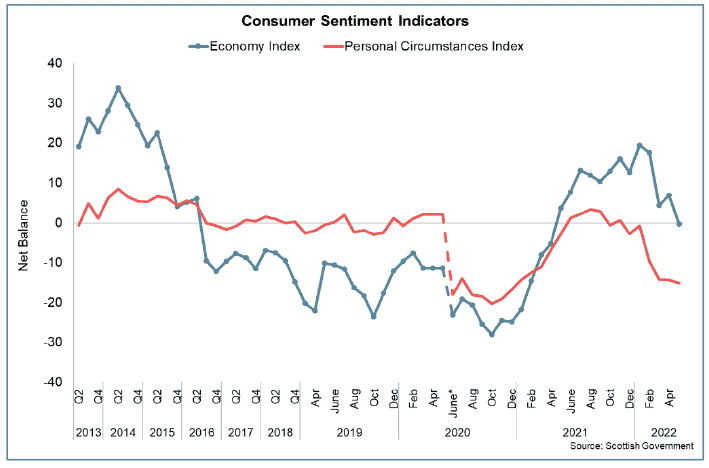
- Overall, the fall in sentiment since the start of the year has been driven by a combination of falling sentiment regarding the economy as a whole, and falling sentiment regarding personal household financial circumstances and personal relaxedness to spending money.
- This reflects the challenging economic environment households are facing and the risks to consumption growth over the months ahead.
Retail Sales and Google Mobility
- Google Mobility data indicates that movement around retail and recreation hubs is continuing to strengthen from the sharp fall in January during the Omicron wave and holiday period.
- Having fallen 30% below pre-pandemic levels in January, movement around retail and recreation hubs in June was back to around 3% below pre-pandemic levels.[16]
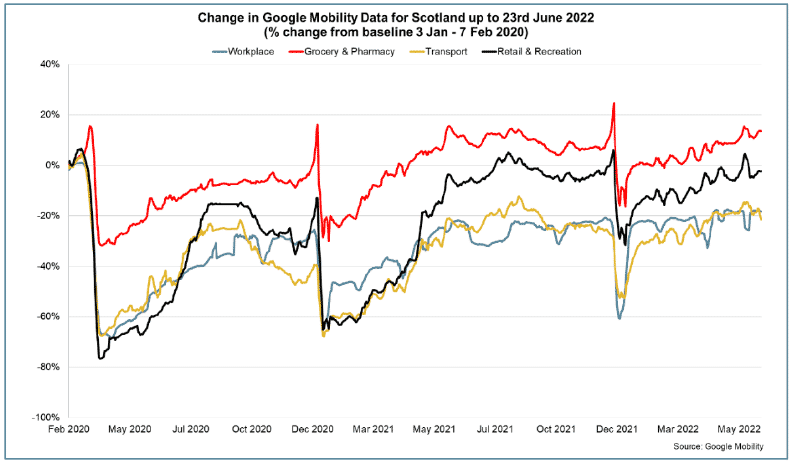
- Having remained stable across late 2021 and early 2022 (excluding holidays), visits to workplaces have marginally strengthened in recent weeks. Visits to workplaces in Scotland in the week to 23rd June were around 18% below their pre-pandemic level (compared to the average of 23% below across September 2021- April 2022, excluding holidays).
- However new working models, including hybrid working, will continue to influence the level of the visits to workplaces and use of transport indicators. Latest BICS data into June indicate that 27.4% of businesses intend to use increased homeworking as a permanent business model going forward (54.6% don’t). This is particularly prevalent in the Information and Communication sector (79%) and Professional, Scientific and Technical Activities sectors (55%).
- Turning to retail, following growth of 0.4% in April, retail sales volumes fell by 0.5% in May 2022. In the three months to May, retail sales volumes fell 1.3% in comparison with the previous three months, a continuation of the downward trend since summer 2021.[17]
- Non-food stores sales remained stable over the month with increases in clothing (+2.2%) offset by falls in sales of household goods (-2.3%), and department stores (-1.1%). The ONS set out that feedback from retailers suggests that consumers are cutting back on spending due to increased prices and affordability concerns, however clothing likely increased over the month due to consumers planning holidays and buying new clothes.
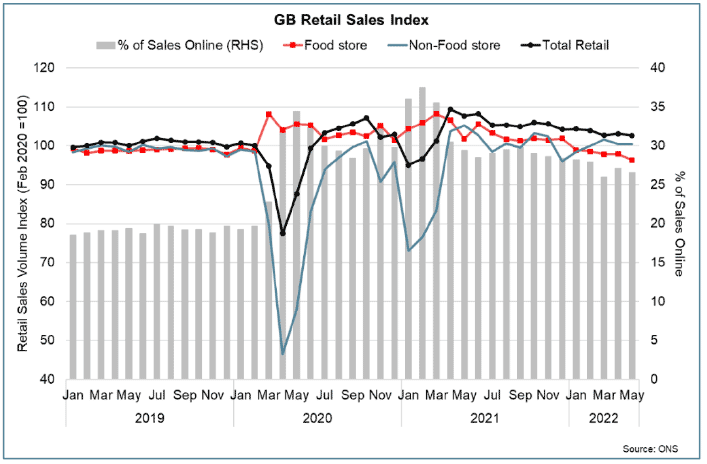
- Following growth of 2.6% in April, automotive fuel sales volumes rose by 1.1% in May. The ONS retail sales publication suggests that the strength in sales, despite rising costs, may in part be linked to the move to hybrid working and a shift away from working exclusively from home.
- Overall, retail sales have fallen 6.2% from their peak in April 2021, though remain 2.6% above their pre-pandemic level in February 2020.
- Online retail as a proportion of all retail sales, fell to 26.6% (down from 27.1% in April). This continues the wider downward trend since its peak in February 2021 (37.7%) though remains significantly higher than in February 2020 prior to the pandemic (19.7%).
Household Savings and Consumer Credit
- At an aggregate level, households increased their levels of savings during the pandemic and reduced net credit levels, due to a reduction in expenditure coupled with a rise in disposable income through the retention of earnings. More recently, saving patterns have returned to levels similar to prior to the pandemic while credit consumption has increased, particularly in the latter half of 2021 and early 2022.
- Bank of England data provides insights at an aggregate level of how savings and consumer credit flows have evolved as restrictions have been removed and economic activity has recovered alongside a rise in inflationary pressures.
- In recent months, at an aggregate level, net flows from UK households into deposit-like accounts have returned to a broadly similar position as they were prior to the pandemic. In May, net inflows eased to £5.7 billion, down from £6.3 billion in April and in line with the pre-pandemic flows which averaged £5.6 billion in the year to February 2020.[18]
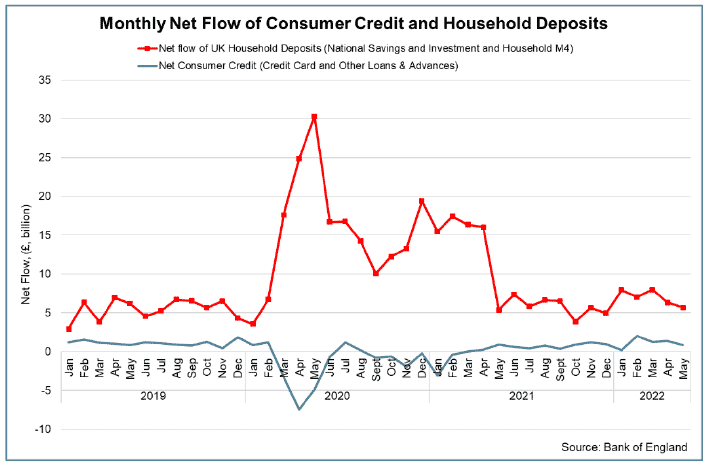
- Alongside this, net consumer credit fell significantly during the pandemic, however started to grow over the course of 2021. In May, consumers’ borrowed an additional £0.8 billion, following £1.4 billion of borrowing in April. This is slightly below the pre-pandemic average up to February 2020 of £1.0 billion.
Inflation
- UK CPI inflation rose to 9.1% in May 2022, up from 9.0% in April and has risen to its highest rate since 1982.[19] Inflation rates have also continued to rise in the US (8.5%) and in the Eurozone (8.6%), in part reflecting rising energy prices over the past year.
- In May, UK consumer prices rose over the year across almost all goods and services monitored. Most notably there was large increases in electricity, gas and fuel prices (+69.9%), in transport (+13.8%, with large increases in motor fuels [+32.8%], second hand car prices [+23.4%] and passenger transport by air [+21.8%]) and in food and non-alcoholic beverages (+9.1%).
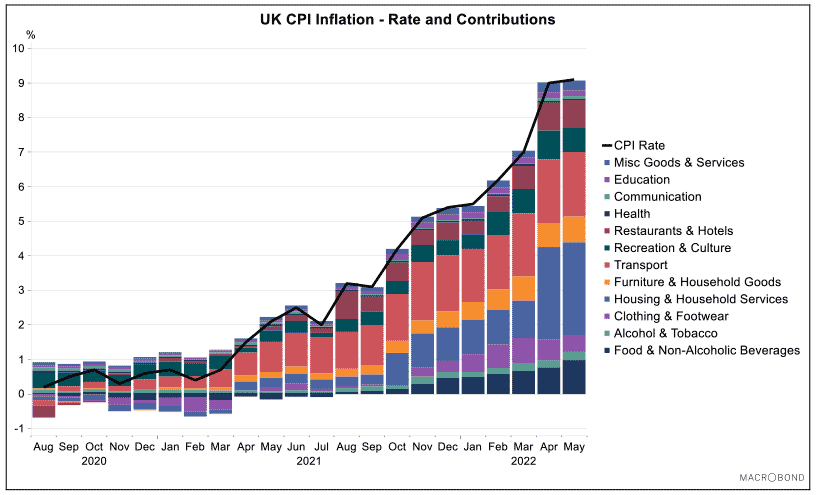
- Looking ahead, the Bank of England forecast inflation to rise to over 11% in October 2022, reflecting higher food, core goods and services price inflation and a prospective large increase in the Ofgem price cap, which are expected to intensify cost of living challenges.
- The pass through of higher energy and material prices from producers to consumers is an important aspect of this. Producer price inflation (changes in the prices of goods bought and sold by UK manufacturers, including price indices of materials and fuels purchased and factory gate prices) has risen over the past year and has remained elevated. In May input price inflation rose to 22.1% (up from 20.9% in April) and is at its highest rate since records began in January 1985, while output price inflation was 15.7% (up from 14.7% in April).[20]
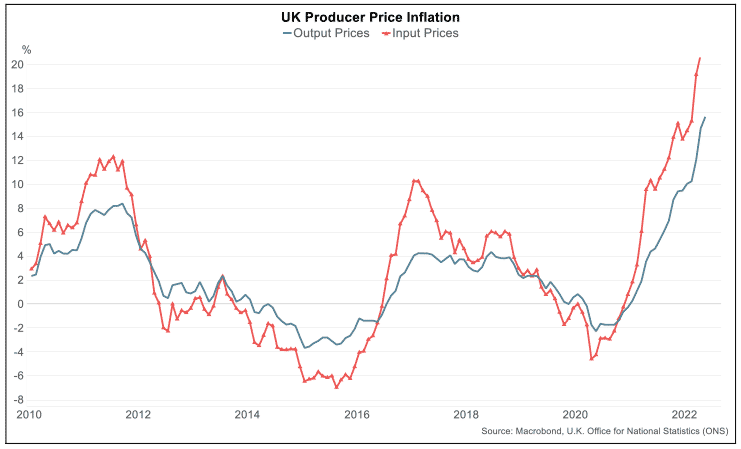
- In response to the further rise in underlying inflationary pressures for the year ahead, the Bank of England’s Monetary Policy Committee (MPC) increased the Bank Rate by 0.25 percentage points to 1.25% in June; its fifth consecutive rate rise since December and up from 0.1% over this period.[21]
Contact
Email: OCEABusiness@gov.scot
There is a problem
Thanks for your feedback